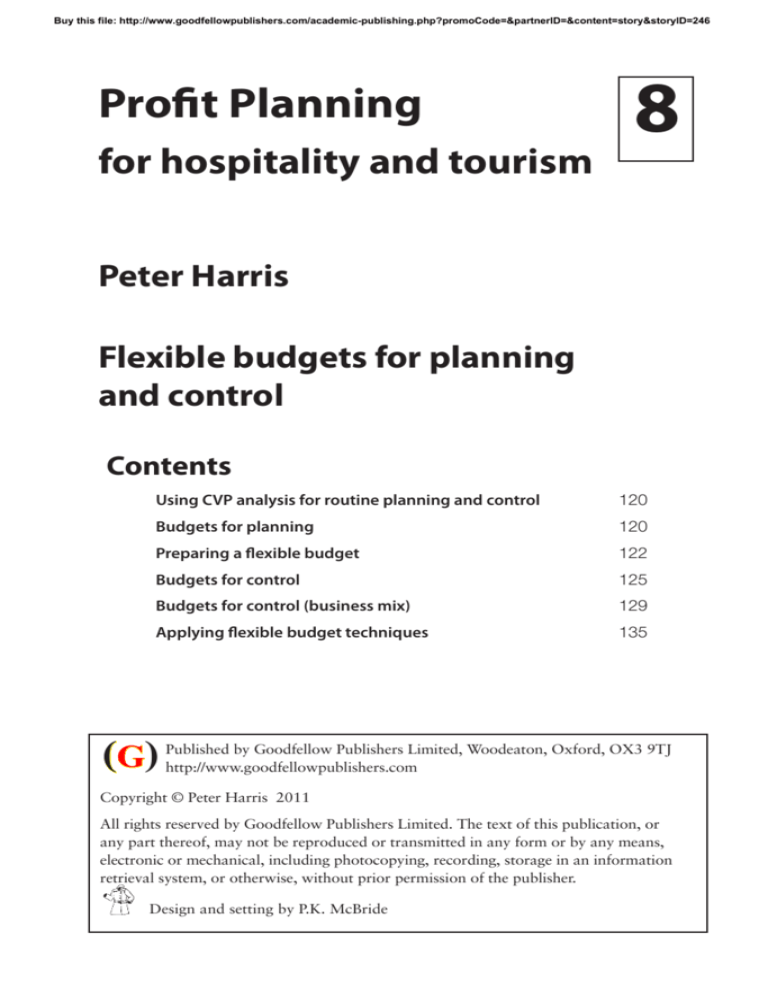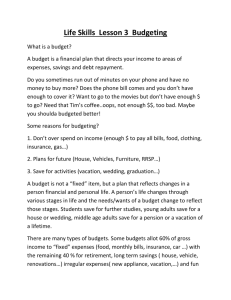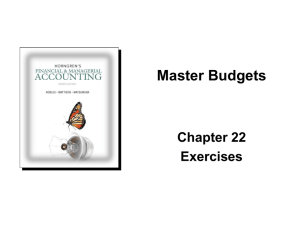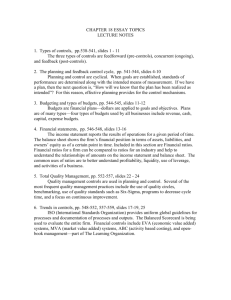
Buy this file: http://www.goodfellowpublishers.com/academic-publishing.php?promoCode=&partnerID=&content=story&storyID=246
Profit Planning
for hospitality and tourism
8
Peter Harris
Flexible budgets for planning
and control
http://www.goodfellowpublishers.com/academic-publishing.php?promoCode=&partnerID=&content=story&storyID=246
Contents
Using CVP analysis for routine planning and control
120
Budgets for planning
120
Preparing a flexible budget
122
Budgets for control
125
Budgets for control (business mix)
129
Applying flexible budget techniques
135
(G)
Published by Goodfellow Publishers Limited, Woodeaton, Oxford, OX3 9TJ
http://www.goodfellowpublishers.com
Copyright © Peter Harris 2011
All rights reserved by Goodfellow Publishers Limited. The text of this publication, or
any part thereof, may not be reproduced or transmitted in any form or by any means,
electronic or mechanical, including photocopying, recording, storage in an information
retrieval system, or otherwise, without prior permission of the publisher.
Design and setting by P.K. McBride
Buy this file: http://www.goodfellowpublishers.com/academic-publishing.php?promoCode=&partnerID=&content=story&storyID=246
8
120 Profit Planning
Flexible budgets for
planning and control
Using CVP analysis for routine planning
and control
In Chapter 7, we saw how to use CVP analysis techniques to gain new insights
into our business undertakings and the nature of our products and/or services
through the eyes of cost structure.
Now, as indicated in Figure 5.1 Profit Planning Framework, we can again benefit
from the ripple effect of dropping a stone into water – analysing cost behaviour
– by applying CVP techniques to routine planning and control decisions.
http://www.goodfellowpublishers.com/academic-publishing.php?promoCode=&partnerID=&content=story&storyID=246
During the process of preparing forecasts, budgets and ‘what if’ scenarios for
business transaction negotiations, it is important to be able to:
Know what to expect in the event of not achieving the anticipated level
of sales volume or other planned objectives, such as budget targets,
conference transaction negotiations and the composition of business
mix.
Compare actual results against past decisions, such as budget projections
and key discrete (individual) business actions so as to monitor outcomes
and learn for the future.
Note: Managers should never approve estimates or forecasts for action without
first assessing the implications of potential under or over-achievement of
subsequent results.
Budgets for planning
What happens if we fail to achieve budgeted target? For instance, we may
anticipate hotel room occupancy at 75% for the coming year and in the event
only achieve 60% occupancy. So, how could a 15 % shortfall in occupancy affect
projected annual profit? Knowing the likely consequences of such a shortfall
means we can consider a counter strategy, should the situation arise.
Buy this file: http://www.goodfellowpublishers.com/academic-publishing.php?promoCode=&partnerID=&content=story&storyID=246
8: Flexible budgets for planning and control 121
Flexible budgets
If we take the case of budget preparation, an effective way to determine the
likely position if we under or overachieve projected results is to prepare a
‘what if’ scenario in the form of a flexible budget prior to the start of the
budget period. A flexible budget is simply a budget that can be adjusted –
flexed – to take account of different levels of sales volume. With our budgeted
profit and loss statement analysed into fixed and variable expenses we can
review revenues at various levels of sales volume within the relevant range of
our business (usually around ±20% of projected revenue) and determine how
profit is likely to be affected.
Note: Although the term ‘flexible budget’ implies budget preparation, the
technique can be applied to a whole range of day-to-day ‘what if?’ decisions
where sales volume is a factor in assessing alternative profit outcomes, such
as new business negotiations.
Let’s consider an example using the figures of the Anchor Hotel, a 50-room
establishment which is open all the year round (365 days). Annual budget
projections have been prepared for the coming year and expenses analysed
http://www.goodfellowpublishers.com/academic-publishing.php?promoCode=&partnerID=&content=story&storyID=246
into their fixed and variable categories, as shown in Figure 8.1.
Room occupancy
Average room rate
Number of covers
Average F&B spend
Sales Revenue:
Room
Food
Beverage
Total revenue
Budget
56%
£50
12,000
£25
£
511,000 (50 × 365 × 0.56 × £50)
200,000
100,000
811,000
Less: variable expenses Room Payroll & other expenses (10%) 51,100
Food cost of sales (40%)
80,000
Beverage cost of sales (30%)
30,000
F&B payroll & other expenses (15%)
45,000
Total variable costs ¹
206,100
Contribution margin (75%)
604,900
(0.10 × £511,000)
(0.40 × £200,000)
(0.30 × £100,000)
(0.15 × £300,000)
27%
Less: fixed expenses
Rooms payroll & other expenses
86,870
F&B payroll & other expenses
60,000
UOE & fixed charges
403,030
Total fixed costs ²
549,900 73%
Net profit before tax
£55,000
Total cost for year ¹+²
£756,000 100%
Figure 8.1: Anchor Hotel: Budgeted marginal profit and loss statement (showing workings)
Chapter extract
To buy the full file, and for copyright
information, click here
http://www.goodfellowpublishers.com/academic-publishing.php?promoCode=&partnerID=&content=story&st
oryID=246
All rights reserved. No part of this publication may be reproduced,
stored in a retrieval system, or transmitted, in any form or by any
means, electronic, mechanical, photocopying, recorded or otherwise,
without the written permission of Goodfellow Publishers Ltd
All requests should by sent in the first instance to
rights@goodfellowpublishers.com
www.goodfellowpublishers.com









